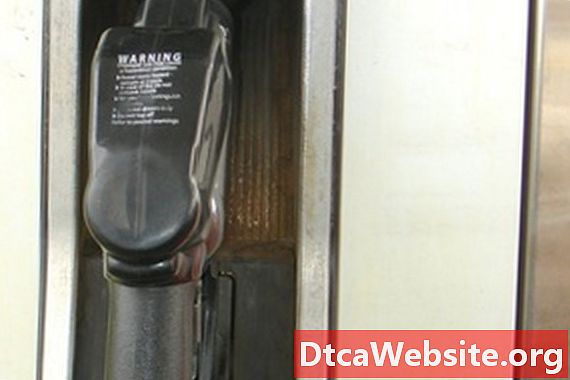
Contenu
- Speedometer and Tach
- Water Temperature and Oil Pressure
- Gas Gauge
- Economy Gauges and InHg
- Exhaust Gas Temperature
- Transmission Temperature

Your car is talking to you. No, not just in the Knight Rider sense that the lady in your SatNav system does; she tells you where youre going, while the gauges in your dash tell you if youre going to get there. A lot has changed since the early days of automobiles, and gauges at one point almost disappeared entirely to be replaced by information-free "idiot lights." Now, much of that same information comes to us through computer displays instead of dials and needles, but the language and the remain the same.
Speedometer and Tach
If youre like most people, odds are good that the speedometer is the gauge you look at most frequently. Its function is simple and self-explanatory. Less obvious is the purpose of the tachometer, which matters quite a bit if youre one of the three people left on Earth who own a manual-transmission car. The tach gives you the engine rpm, which is functionally useless information in an automatic. Experienced manual-trans drivers rarely use it in daily driving, since they quickly learn to shift by sound. However, if youre going for fuel economy, its usually best to shift at about 40 to 50 percent of your engines redline. Youll usually find the quickest timeslips at the drag strip, shifting just a bit short of the engines redline at about 90 to 95 percent of maximum rpm.
Water Temperature and Oil Pressure
Unless you have a computerized display, chances are good your water temp and oil pressure gauges are calibrated with a colored "normal" zone and oriented so that ideal running temperature and pressure are at the needles 12 oclock position. To the left, the engines cold or oil pressure is low; to the right, the engine is hot or the oil pressure is high. Some cars have horizontal or vertical "sweep" or "ribbon" style gauges instead of clock-type dials, but the principle is the same. In terms of actual temperature, modern engines usually run much hotter than older ones -- 210 to 220 degrees Fahrenheit is normal these days, instead of the 160 to 180F for older cars. Rule of thumb for oil pressure is 10 psi per thousand rpm, up to maximum pressure -- usually 40 to 60 psi. Check your owners manual, though, because running oil pressure varies greatly by engine design.
Gas Gauge
For the sake of due process, the gas gauge is probably worth mentioning, although, if you dont know how that works, you probably havent driven very far lately. Even if you do know how to read your gauge, never trust it. You may have noticed that the gauge seems to drop at different rates depending on how full the tank is. Thats not uncommon and not accidental. If it reads 2/3 full, its probably three-quarters full. If it reads 1/2, its probably two-thirds full -- and if it reads 1/4, its probably close to half. Thats just manufacturers encouraging owners not to run the vehicle to the last drop. Theres a lot of junk floating around in your fuel tank, and running it consistently low will greatly shorten the life of your fuel filter, pump and -- potentially -- the engine. So, yes, your gauge is a liar, but it has good intentions. Just pretend you believe it and keep it out of the red zone whenever possible.
Economy Gauges and InHg
Whats an "InHg?" If youre fortunate, your cars computer display may display this as "manifold vacuum." The weird abbreviation stands for "inches of mercury," which is how we measure vacuum. In the days before instant fuel economy displays, people installed vacuum gauges to help them maximize fuel economy. Youll still see these "economy gauges" from time to time. Higher intake manifold vacuum -- more "inches" or "inHgs" -- means greater fuel economy. Lower engine vacuum means lower economy. Thats still generally true today, particularly with automatic transmission vehicles. Odds are good that if you have an inHg readout in a modern car, you also have a computerized instant fuel economy readout. Still, though, its good to know, just in case.
Exhaust Gas Temperature
The Exhaust Gas Temperature gauge applies primarily to diesels; it tells you how much fuel is going out of the cylinder while still burning, which speaks volumes as to how hard the engine is working and how much fuel its wasting. This makes EGT gauges the diesel equivalent to intake manifold vacuum gauges on gas engines. Lower EGTs mean better fuel economy, higher EGTs mean more power. About 500 to 600 is normal under cruise conditions, and 1200 to 1400 is the high range for most diesels under full throttle and high-load conditions like going uphill or towing. As a diagnostic tool, the EGT can tell you a lot about the engines air-fuel ratio -- many diesel mechanics think of it as the single most important gauge on an oil burner. For most people, though, its just a good way to maximize fuel economy and keep the engine from overheating under heavy loads.
Transmission Temperature
Transmission temperature is generally only relevant for either tow vehicles or super-high-performance racers. The harder you push a vehicle, the hotter the transmission will get. When it reaches a certain point, the fluid breaks down and becomes useless as a lubricant and friction modifier in the clutches. When that happens, clutch burning and transmission failure is almost inevitable. Tow vehicles usually have some kind of transmission temperature gauge, and its as important to your tranny as the engine temperature gauge is to the engine. Again, youll normally see these with a kind of "normal" range indicator, and factory tow packages often network them to an idiot light to tell you when the transmissions overheating. For most vehicles, 175-ish is the ideal, but 160 to 190 degrees is normal. Extremes as far as 150 to 250 are usually acceptable for short periods. Anything higher than 250 to 275, and youre risking fluid breakdown and damage to the transmission.


